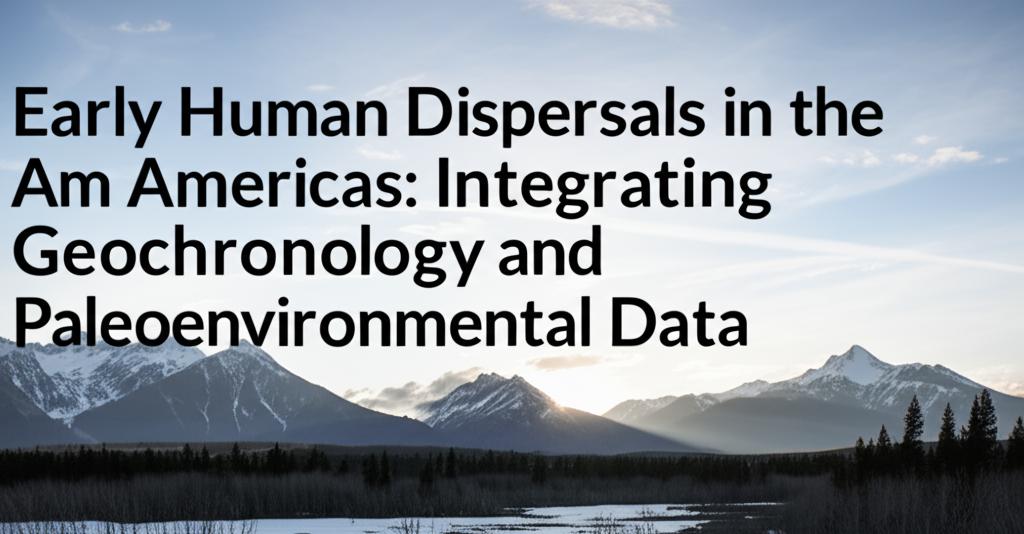The peopling of the Americas is a captivating and evolving field of study, with new research continually refining our understanding of when and how the first humans arrived and spread across these continents. Integrating precise dating techniques (geochronology) with the reconstruction of past environments (paleoenvironmental data) is crucial to piecing together this complex puzzle.
Key Developments and Understandings:- Challenging Older Models: The long-held "Clovis-first" model, which proposed that humans first entered the Americas around 13,000 years ago, is no longer considered to fully explain the initial peopling. A growing body of evidence from archaeological sites across both North and South America suggests earlier human presence.
- The Beringian Standstill Hypothesis and Beyond: Genetic studies, particularly those analyzing mitochondrial DNA from ancient and modern Native Americans, have been instrumental. These studies indicate that the ancestors of Native Americans diverged from Asian populations and spent a period isolated in Beringia – the landmass that once connected Asia and North America – perhaps for thousands of years during the Last Glacial Maximum (LGM), roughly 20,000 to 21,000 years ago. Following this "Beringian Standstill," populations began to move south into the Americas.
- Multiple Lines of Evidence and Dating Techniques: The reliability of early site dates is a constant subject of rigorous debate. To address this, researchers are employing multiple dating methods. For instance, at the White Sands National Park site in New Mexico, where human footprints were discovered, initial radiocarbon dating of embedded plant seeds suggested an age of 21,000 to 23,000 years. Subsequent research aimed to corroborate this by dating pine pollen (which avoids potential carbon contamination from ancient lake water) and using optically stimulated luminescence (OSL) dating on quartz grains to determine when they were last exposed to sunlight. These newer methods also pointed to a similar age range, strengthening the case for an earlier human presence.
- Coastal vs. Interior Routes: The debate continues regarding the primary routes of dispersal. While the interior "ice-free corridor" through Canada was once considered the main pathway, evidence suggests it may not have been habitable until later. The Pacific coastal route is gaining more support as a viable, and possibly earlier, migration path. Paleoceanographic data and climate models are used to reconstruct the feasibility of this coastal route, considering factors like glacier extent, sea ice, ocean currents, and the availability of marine and terrestrial resources. Studies suggest favorable time windows for coastal migration could have been between approximately 24,500 to 22,000 years ago and again between 16,400 to 14,800 years ago. Some researchers even propose that early peoples might have utilized winter sea ice to navigate between islands and coastal refugia.
- Paleoenvironmental Reconstruction: Understanding the environments early humans encountered is critical. This involves analyzing late Pleistocene and early Holocene climate and vegetation changes. For example, research on the development of shellfish beds indicates that viable coastal ecosystems, like oyster reefs, could form relatively quickly, potentially providing a reliable food source for pre-Clovis and Paleoindian populations even during periods of sea-level rise. Reconstructing ancient landscapes, including paleo-lakes and wetlands, provides insights into resource availability and how early peoples adapted.
- South American Evidence: Sites like Monte Verde in Chile provide some of the most compelling evidence for an early human presence in South America, with radiocarbon and luminescence dating suggesting ephemeral human activity between approximately 18,500 and 14,500 years ago. This indicates that humans were adaptable and present in diverse environments, including cold, non-glacial settings, much earlier than previously thought.
- Genetic Complexity: Paleogenomic research has revolutionized the field. Ancient DNA analysis shows that Native American ancestors formed in Siberia or the Amur region through admixture with Ancient North Eurasian and East Asian populations. Genetic data also reveals complex migration patterns, with evidence for multiple dispersals and population replacements or admixtures within the Americas. For example, studies suggest a split of Native American ancestors between 18,000 and 14,000 years ago into different branches that further diversified.
- Ongoing Discoveries and Debates: The field is dynamic, with new sites and data continually emerging, leading to ongoing refinement of models. While some an uncontroversial human presence is widely accepted by at least 15,000-16,000 years ago, claims for much earlier occupations (e.g., 30,000 years ago or more at sites in Mexico or Brazil) remain highly debated and require further rigorous investigation.
In summary, the integration of advanced geochronological methods and detailed paleoenvironmental reconstructions, alongside sophisticated genetic analyses, is painting an increasingly complex and ancient picture of human dispersal into the Americas. While a consensus is forming around a pre-Clovis peopling, the precise timing, routes, and adaptive strategies of the earliest Americans continue to be active areas of research and discussion.

